This first table shows the MCR320-QPK’s W/10ΔT numbers in a quick glance chart format.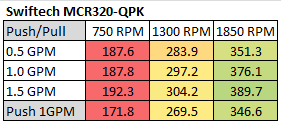 Using this data we can effectively show percentage gains/losses relative to a reference point. It’s an interesting way to show gains/losses while changing a variable.
Using this data we can effectively show percentage gains/losses relative to a reference point. It’s an interesting way to show gains/losses while changing a variable.
So, let’s focus on 1300 RPM as our reference and see how much gain or loss in performance we get by changing fan speed up and down.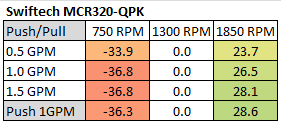
In our Tuning Table for Flow Rate Variance with 1.0 GPM as a reference point, we again see little variance between results when changing flow rates at the same fan speed.
The next three tables have specific reference points set for gain and loss comparison.
1.0 GPM @ 1300 RPM reference point.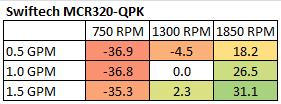
0.5 GPM @ 750 RPM reference point.
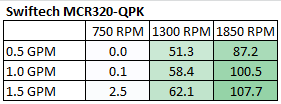
1.5 GPM @ 1850 RPM reference point.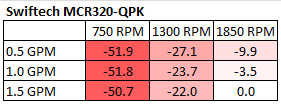
So from the data above we’re getting a good idea of how the MCR320-QPK radiator performs relative to itself. But there is a large selection of 360mm radiator models to choose from, so let’s put the MCR320-QPK’s results into some comparison charts.
As with our previous Slim 360mm radiator reviews, we’ll only comment and score on comparisons made against other Slim 360s. For those interested we’ll also make available the data against all the 360mm models, but they will be “spoilered” and not commented on.
There is a LOT of data which make up our charts and previously we have not published all of it. After receiving requests for certain data to be included we’ve decided to now include even more plots. Aware that we are at data saturation point and are at risk of the page becoming information overkill – we’ll try and keep things somewhat simplified by applying spoilers on some plots from now on. All the data will still be available, just means a few extra click for those who wish to analyze everything.
Push Only Data vs Competition
Focusing on the Push Only results for now, we’ll get to the Push/Pull data later.
Let’s start with 750 RPM and see how the MCR320-QPK compares.
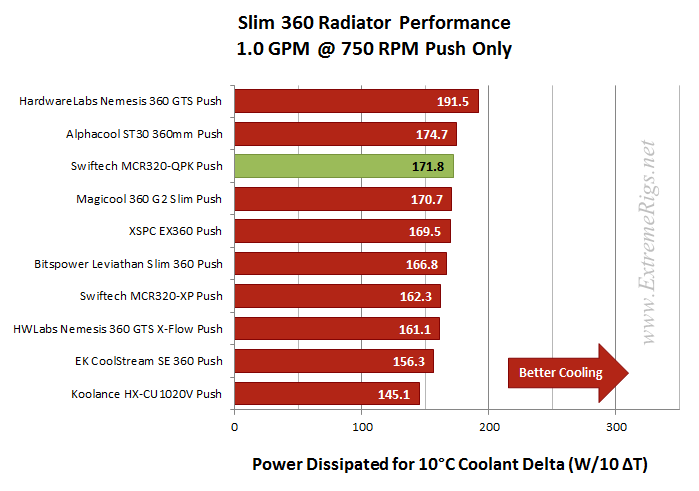 The MCR320-QPK finished in 3rd place of slim 360mm radiators tested in Push Only at 750 RPM. Being marketed as a slow to medium fan radiator this is a great result for the MCR320-QPK and in line with our expectations.
The MCR320-QPK finished in 3rd place of slim 360mm radiators tested in Push Only at 750 RPM. Being marketed as a slow to medium fan radiator this is a great result for the MCR320-QPK and in line with our expectations.
Now let’s look at 1300 rpm:
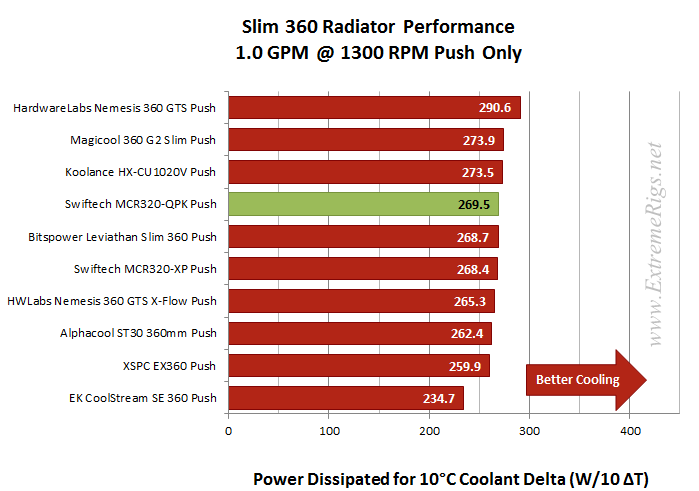 For Push Only 1300 the MCR320-QPK drops a ranking position but is still very competitive and even beats it’s XP stable mate which is supposed to be tuned for medium to high speed fans.
For Push Only 1300 the MCR320-QPK drops a ranking position but is still very competitive and even beats it’s XP stable mate which is supposed to be tuned for medium to high speed fans.
Now 1850 rpm Push Only:
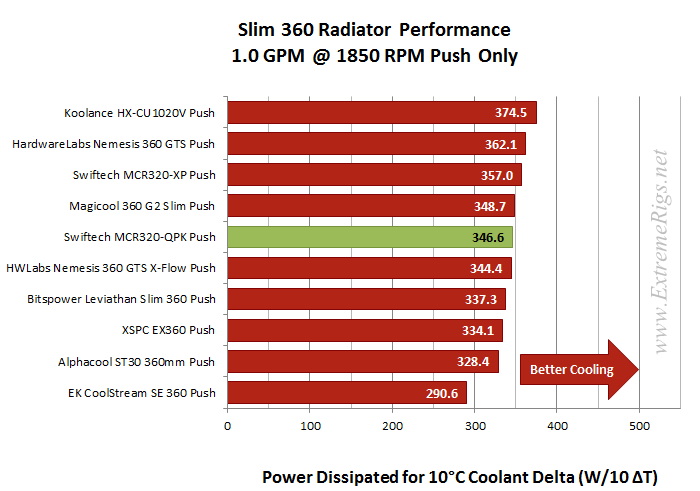 At 1850 rpm the MCR320-QPK drops another ranking position but is still in the top half of the contenders. We see a bit more separation now as subtle variations of each design show their strengths and weaknesses. The higher fan speed XP variant from Swiftech has now taken over the QPK, but is only 3% ahead of it.
At 1850 rpm the MCR320-QPK drops another ranking position but is still in the top half of the contenders. We see a bit more separation now as subtle variations of each design show their strengths and weaknesses. The higher fan speed XP variant from Swiftech has now taken over the QPK, but is only 3% ahead of it.
The MCR320-QPK turned in a solid Push Only data set with results that beat out the majority of the field at every data point.
We have created one more chart to share for Push Only. Here we have plotted the MCR320-QPK against the best and worst performing 360mm slim radiators in Push only.
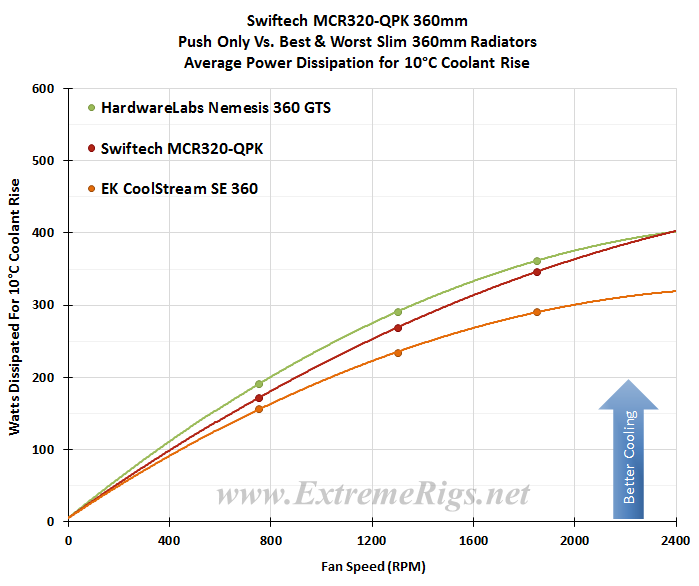
Now let’s find out how the MCR320-QPK performs with Push/Pull fans.
Push/Pull is possibly the most unlikely installation scenario for the MCR320-QPK. It’s a set-up which we would not recommend using for any Slim radiator. The benefits of Push/Pull on a slim rad aren’t great enough to warrant the extra space required. If you have 80mm of space available (slim rad + 2 fans) we would advise investigating a thicker radiator with a Push Only fan assembly.
Push/Pull Data vs. Competition
For Push/Pull comparisons we display the plot and comment on the averaged results at each fan speed for the Slim 360mm radiators only. Individual ranking plots for each flow rate / fan speed are spoilered as are averaged results against all 360mm radiators.
Firstly the 750 rpm:
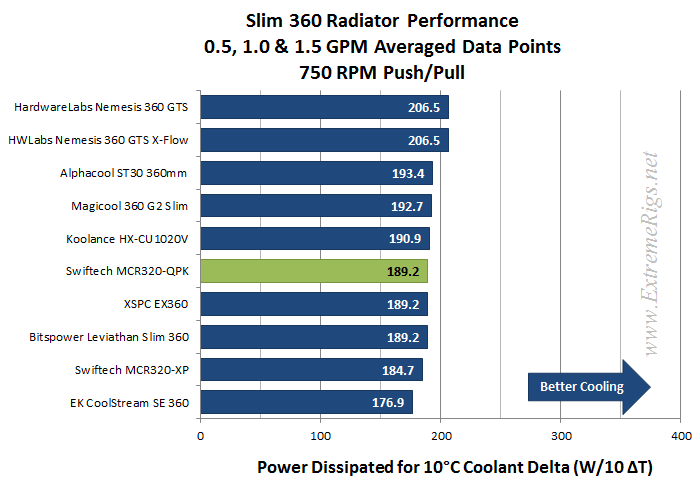 The MCR320-QPK lands in 6th position with a low speed Push/Pull fan assembly which is a slight drop from the 3rd place it had in Push Only. There were two clear winners while the rest including the MRC320-QPK had very close results. The difference between 3rd place and the MCR320-QPK for the averaged results here was less than 1%.
The MCR320-QPK lands in 6th position with a low speed Push/Pull fan assembly which is a slight drop from the 3rd place it had in Push Only. There were two clear winners while the rest including the MRC320-QPK had very close results. The difference between 3rd place and the MCR320-QPK for the averaged results here was less than 1%.
Let’s move to 1300 rpm:
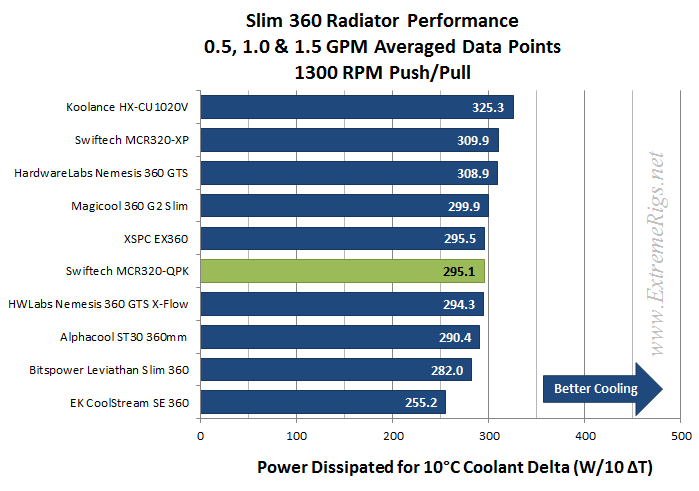 At 1300 rpm Push/Pull the MCR320-QPK’s ranks in the middle of a tightly grouped pack. The XP variant now has a clear advantage over the QPK.
At 1300 rpm Push/Pull the MCR320-QPK’s ranks in the middle of a tightly grouped pack. The XP variant now has a clear advantage over the QPK.
Now 1850 rpm:
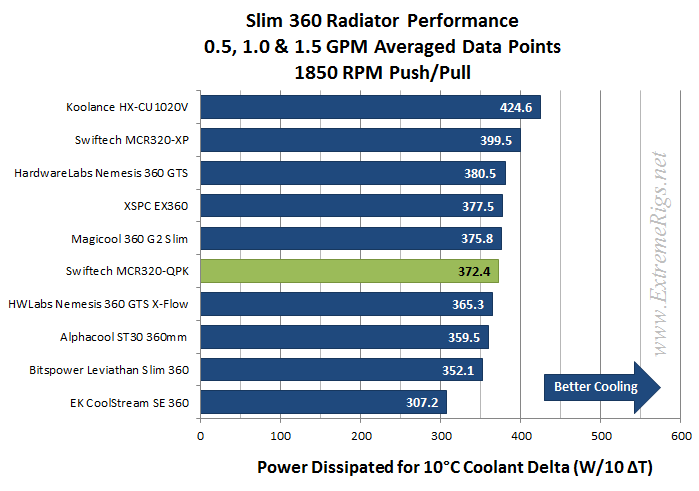 As in the Push/Pull 1300, the MCR320-QPK finished in the middle of the rankings for Push/Pull 1850. A respectable result indeed for a radiator marketed for slow to medium speed fans.
As in the Push/Pull 1300, the MCR320-QPK finished in the middle of the rankings for Push/Pull 1850. A respectable result indeed for a radiator marketed for slow to medium speed fans.
The next chart has the MCR320-QPK plotted against the best and worst performers of the test group with Push/Pull fans. The data used is from the Averaged results charts above.
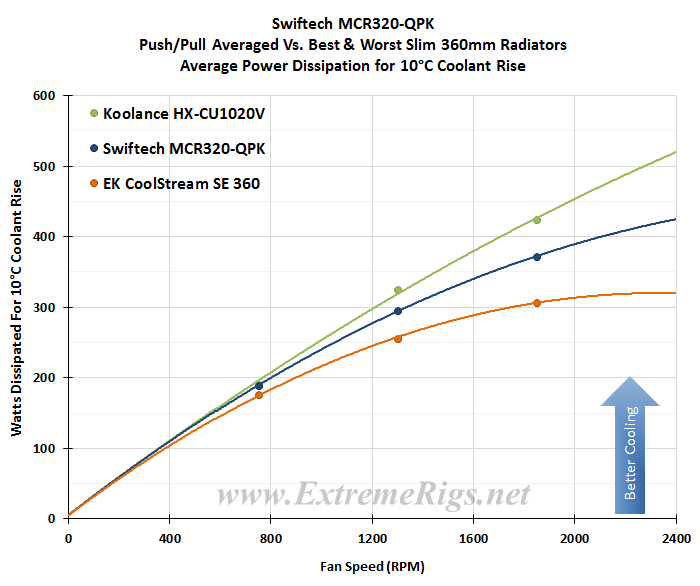
Let’s now combine the Push Only and Push/Pull results for our slim 360mm radiators at 1.0 GPM for each fan speed so we see both sets of results on the same plot. Sometimes these combined plots show up some points of interest, however they are long, so again a spoiler has been used.
From all the test results we created “Average Performance Factor” charts for both Push and Push/Pull. We then made a combined plot of the average called the “Master Performance Factor”. The radiator with the best cooling ability (W/10ΔT) at each rpm was awarded a score of 100. Each other radiators W/10ΔT result was scored as percentage of the top performer.
This way of looking at the comparison takes away any advantages that a radiator may have at higher or lower fan speeds and looks at an overall average. While this appears fair it does tend to favor those radiators that are all-rounders and those radiators which do very well at high RPM. Most users should be more focused on their specific use case.
Apart from the Push Relative to Push/Pull which is a self comparison, the MCR320-QPK’s percentage scores in the table below are relative to the best performer at each data point. We again advise readers to cross reference specifications and results for each radiator and keep in mind your intended fan assembly and operating speed.
This table confirms that the MCR320-QPK turned in good results for the low and medium fan speeds and even a a very good Push Only result with high speed fans. It struggled to keep up with high fan speeds in Push/Pull. Using any slim radiator with Push/Pull fans is not going to yield huge gains over a Push Only fan assembly, so it is not one which we recommend anyway.
The percentage numbers in the table above offer another way of looking at the MCR320-QPK’s results. But for our scoring system we need a way to reduce the categories while retaining the data. To do this we average the results for each fan assembly type giving us Averaged Performance Factors. We calculate this for Push Only, Push/Pull and finally an average of everything.
Firstly – the Push Only APF:
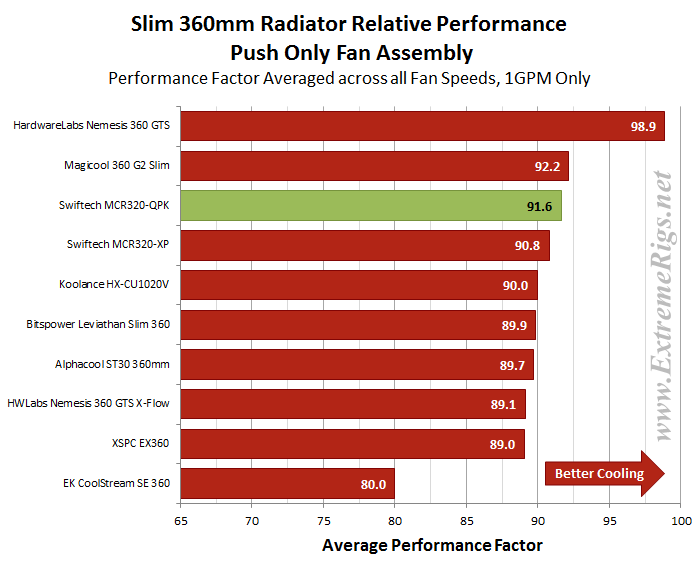 With an 91.6 % Averaged Push Only result the MCR320-QPK is lands in 3rd position after a solid performance with all fan speeds.
With an 91.6 % Averaged Push Only result the MCR320-QPK is lands in 3rd position after a solid performance with all fan speeds.
Now the Push/Pull APF:
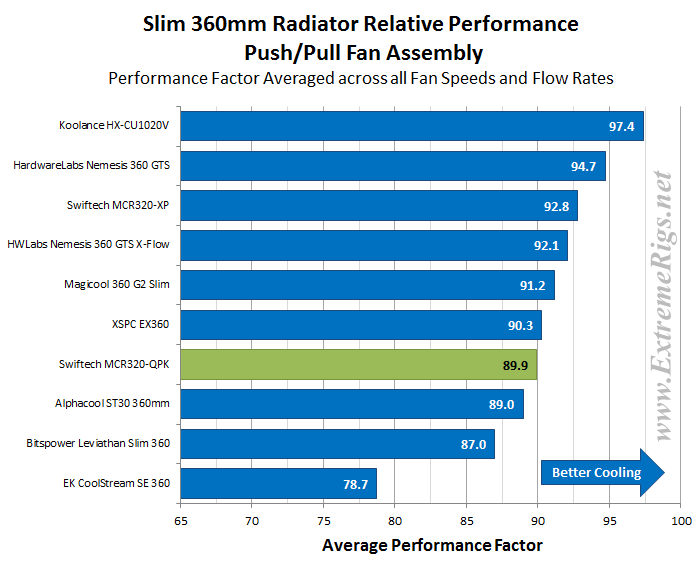 The MCR320-QPK finishes in the lower half of the rankings, however with an 89.9 Push/Pull APF it is was only ~8% behind the category winner. We think this is a darned good effort for a 13 FPI radiator competing against models with more densely populated cores.
The MCR320-QPK finishes in the lower half of the rankings, however with an 89.9 Push/Pull APF it is was only ~8% behind the category winner. We think this is a darned good effort for a 13 FPI radiator competing against models with more densely populated cores.
Finally for thermal performance we created the Master Performance Factor which is calculated from the averaged results of all the Push Only and Push/Pull thermal tests, at all fan speeds and flow rates.
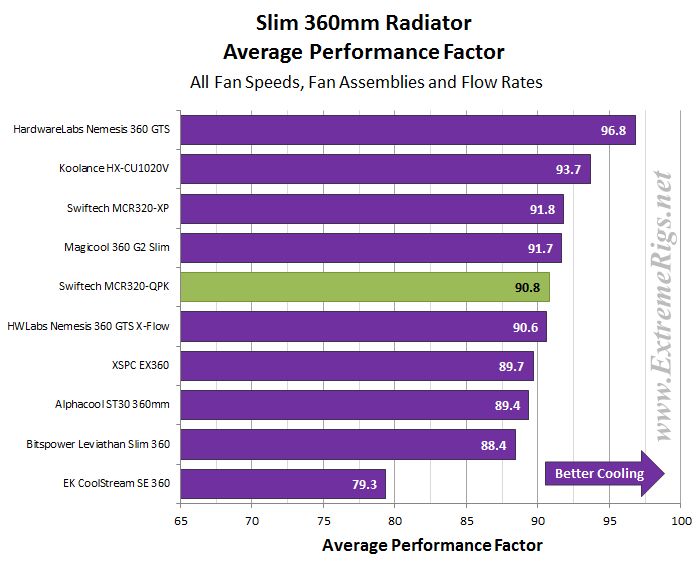 The MPF result of 90.8 was just 6% behind the overall winning. Along with it’s top 5 ranking the MCR320-QPK proved to be more of an all-rounder than just being good with slow to medium speed fans as indicated it would be from the specifications and Swiftech’s marketing material.
The MPF result of 90.8 was just 6% behind the overall winning. Along with it’s top 5 ranking the MCR320-QPK proved to be more of an all-rounder than just being good with slow to medium speed fans as indicated it would be from the specifications and Swiftech’s marketing material.
Space Efficiency
The MCR320-QPK’s space efficiency vs. performance is unlikely to result in a high score against the other slim radiators because it is the equal second thickest of the group. We have used the Average Performance Factor results from the charts above to compile two plots which shows us how it compares to the other radiators in terms of performance Vs. space taken.
Firstly is radiator thickness Vs. APF
Here the combined APF scores were divided by the only radiator thickness, with the highest (most space efficient) issued a score of 100. Each of the other radiators results was converted to a percentage of the most space efficient radiator’s score.
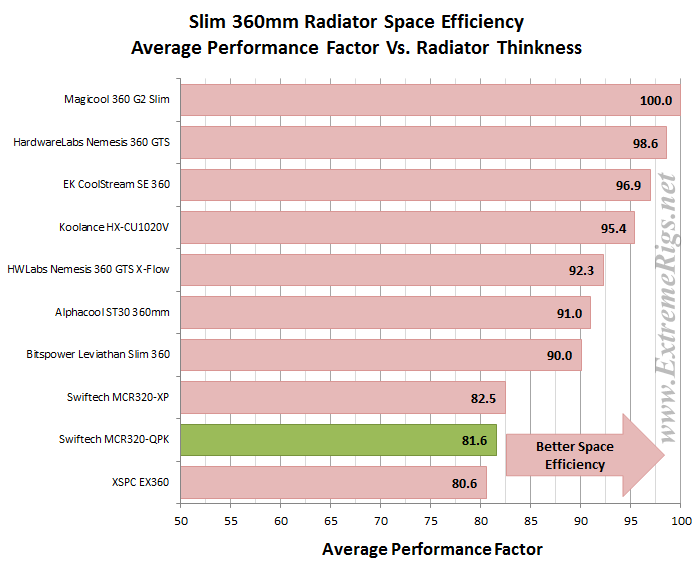
The results end almost in order of thinnest to thickest. This is particularly true when comparing to all radiators and not just slim results.
Next we took the APF results for Push/Pull and divided it by the total thickness including the fans and applied the same scoring system. For the Push Only we used the Push Only Vs Push/Pull comparative results and applied the same scoring system when compared against the Push/Pull.
The rankings are ordered for Push Only as that is the most efficient fan assembly and each radiator’s Push/Pull result are placed un-ordered, just below it’s ranked Push Only score.
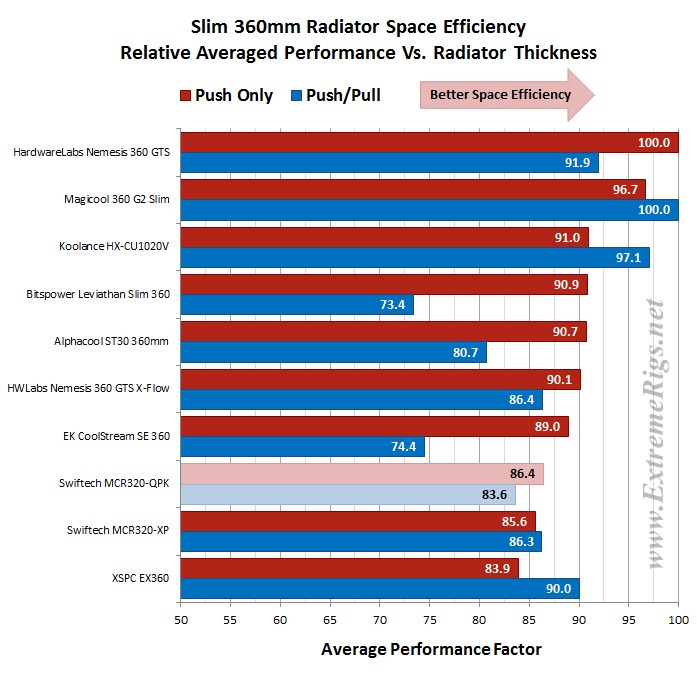 This plot is likely the most useful for readers of the 2 plots for space efficiency even though it is harder to decipher, especially the Push/Pull rankings. With fan thickness factored in the MCR320-QPK finishes 3rd last for Push Only while it’s Push/Pull result is 4th last.
This plot is likely the most useful for readers of the 2 plots for space efficiency even though it is harder to decipher, especially the Push/Pull rankings. With fan thickness factored in the MCR320-QPK finishes 3rd last for Push Only while it’s Push/Pull result is 4th last.
Value Factor
While our APF’s are still fresh in mind, let’s now look at some performance results vs radiator price to show which of the 360mm radiators might offer the best bang for your buck. Each radiator’s combined APF scores were divided by the radiator cost and again we applied our scoring system of percentage Vs. the best performer of the category.
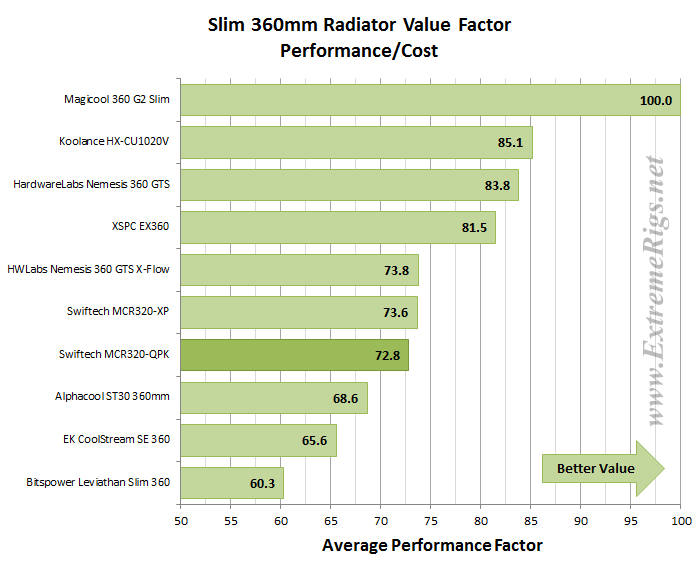 The MCR320-QPK’s Value Factor turns out looking to be quite low. In fact the majority of the field score low due to the aggressively priced Magicool radiator. The average price for the group is ~$65. The Swiftech models are both $68 while the Magicool retails for $50. This $50 price has a significant impact on the other radiators value metric.
The MCR320-QPK’s Value Factor turns out looking to be quite low. In fact the majority of the field score low due to the aggressively priced Magicool radiator. The average price for the group is ~$65. The Swiftech models are both $68 while the Magicool retails for $50. This $50 price has a significant impact on the other radiators value metric.
Next Up – Summary!








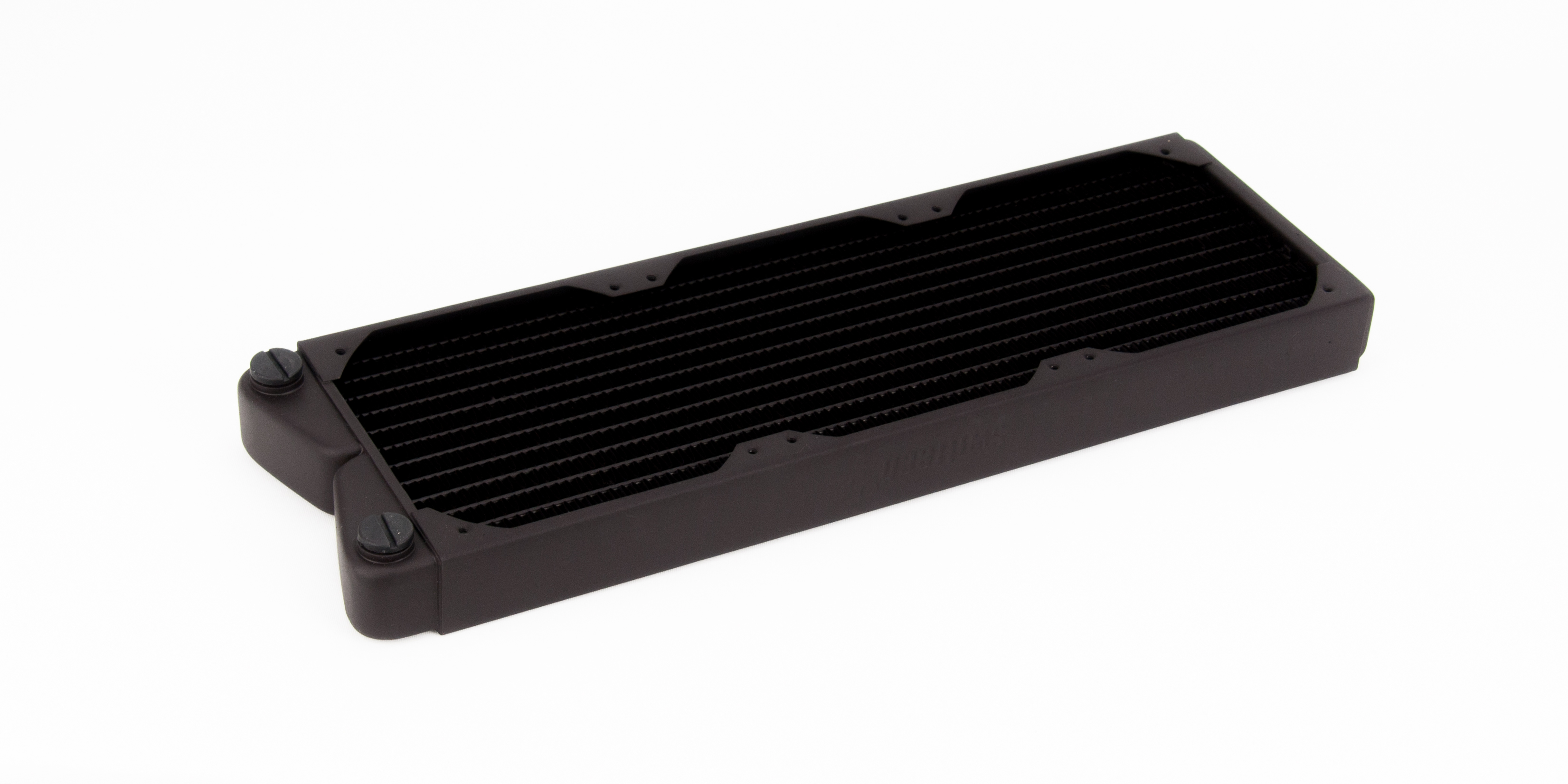
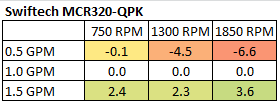
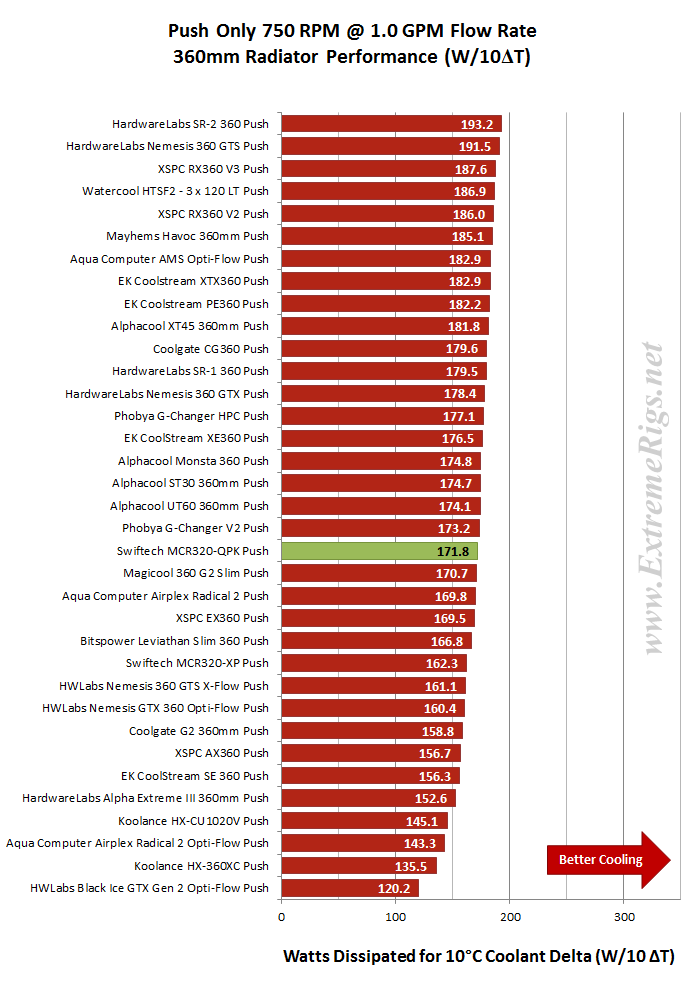
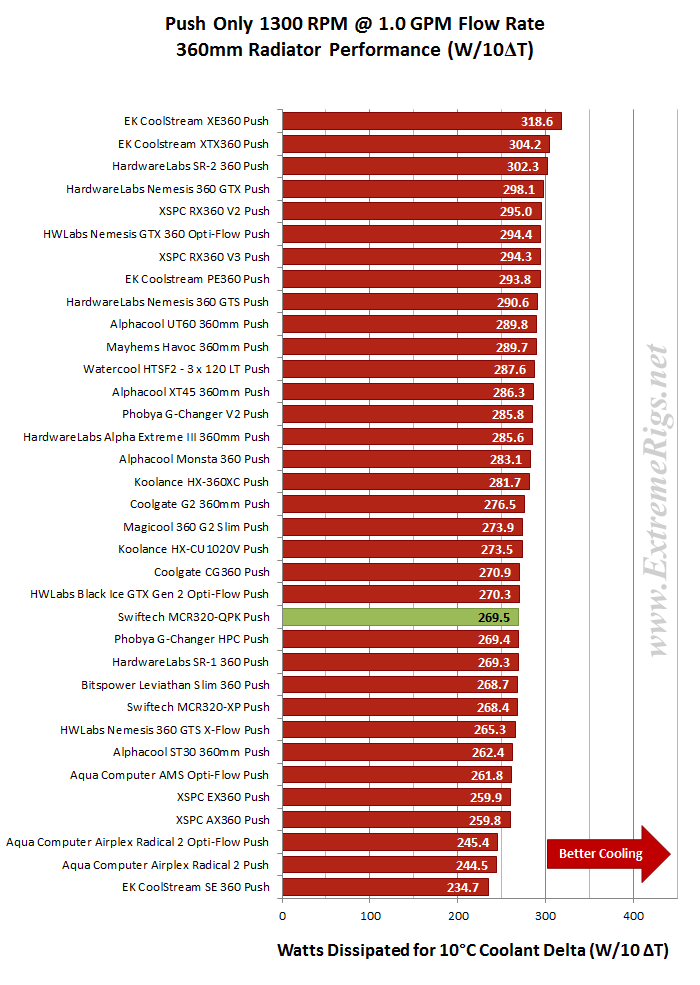
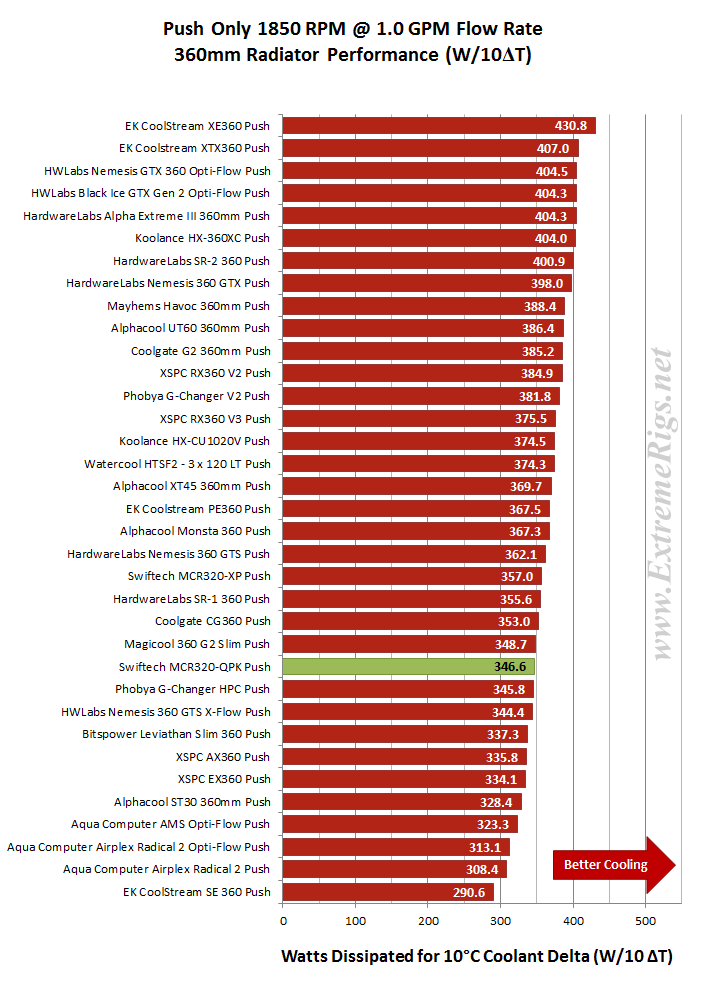
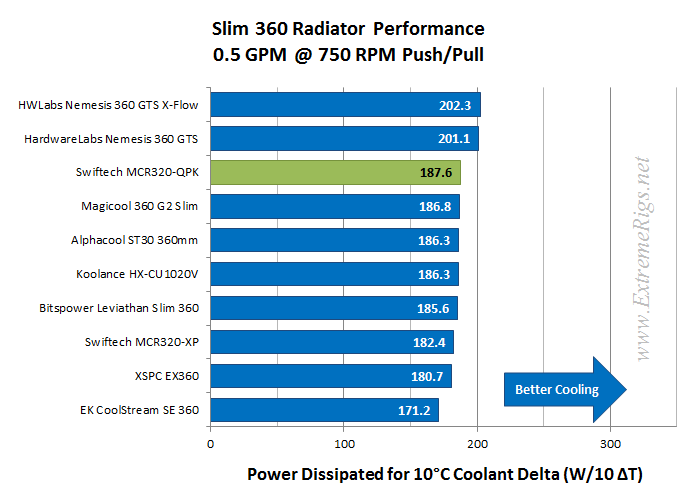
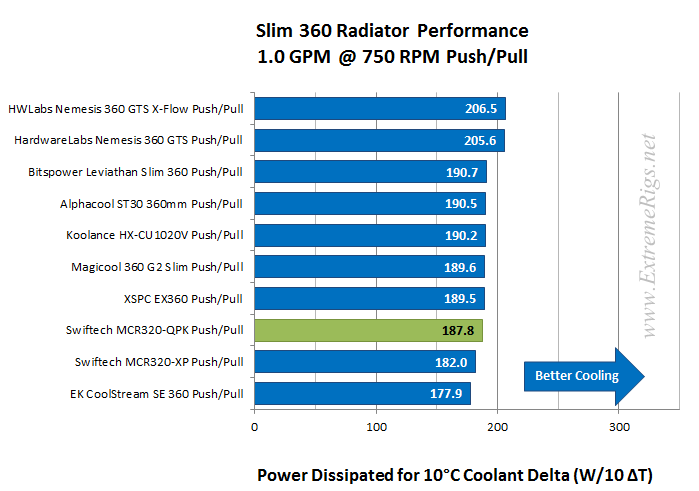
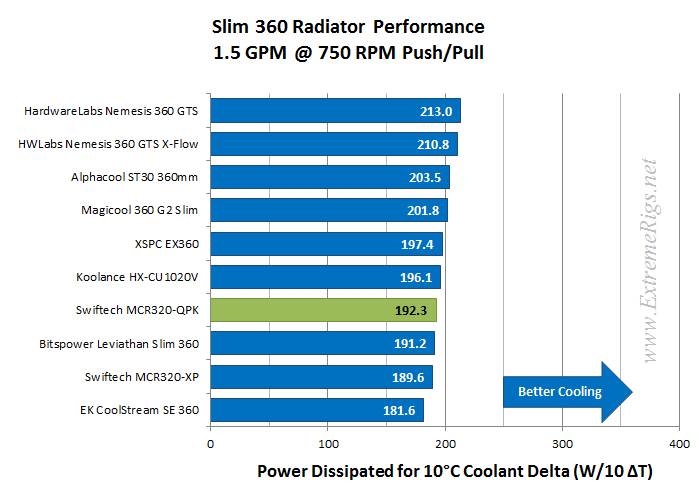
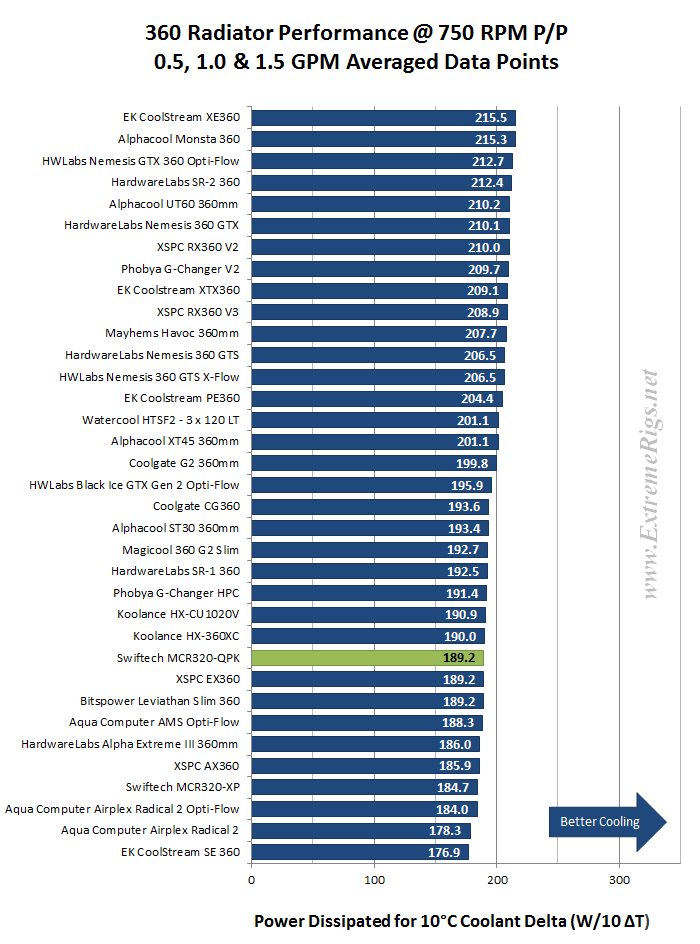
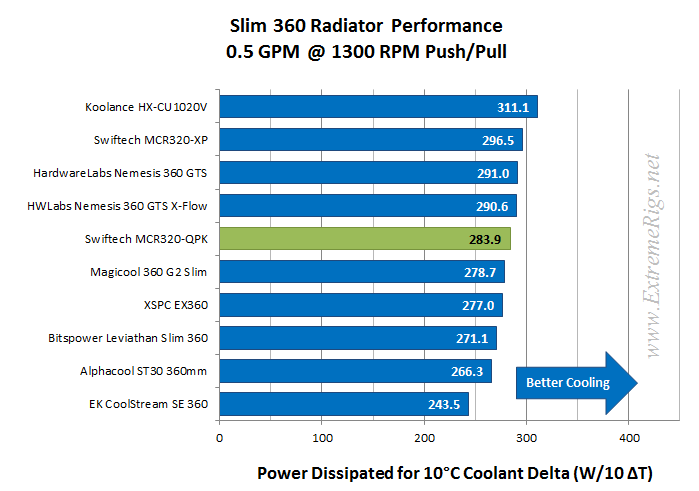
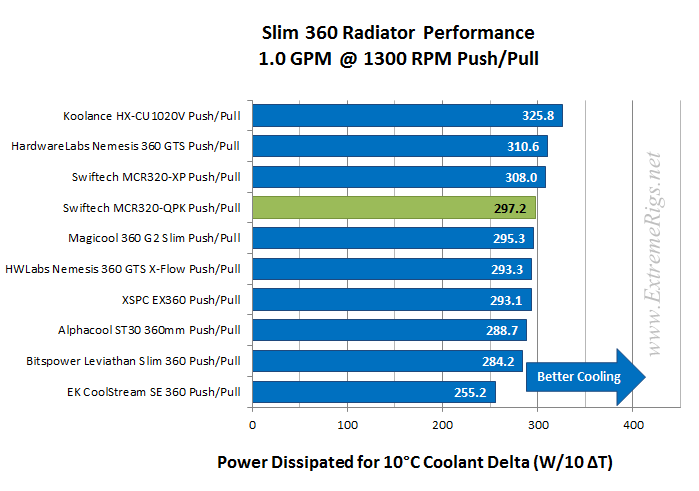
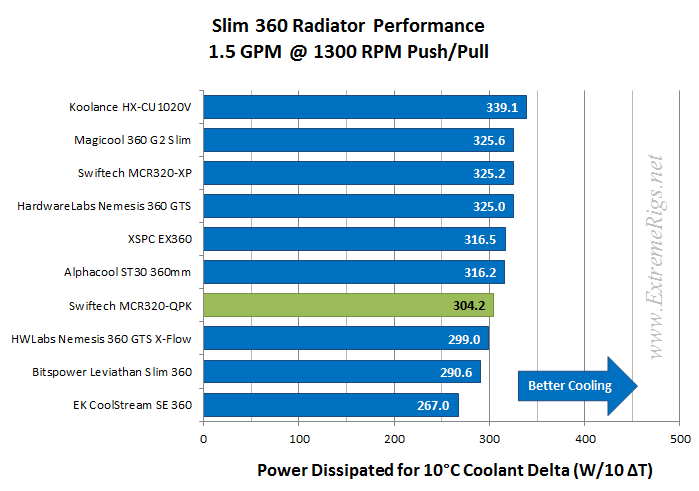
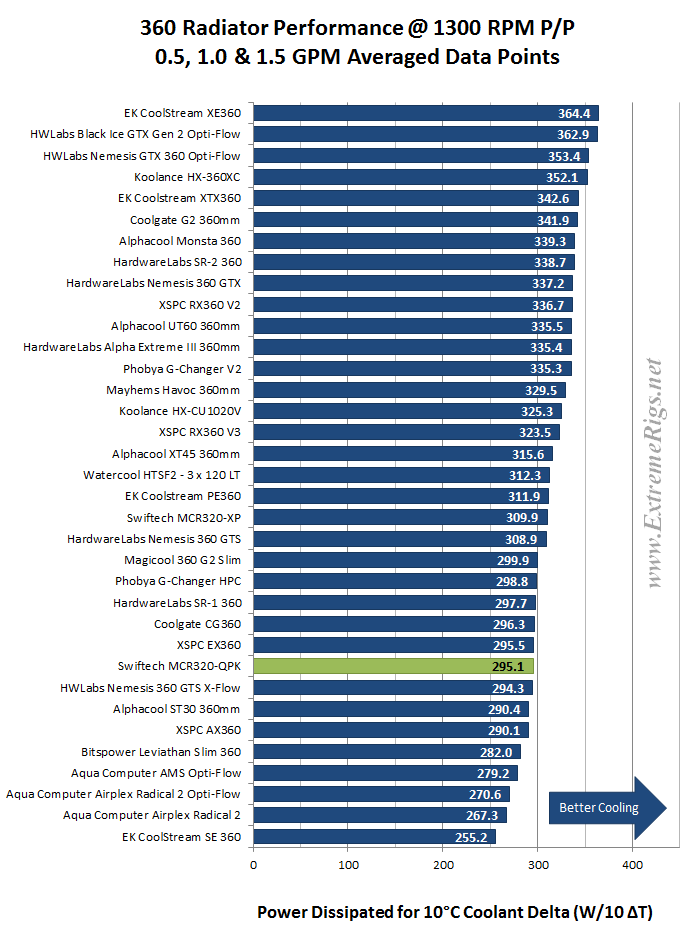
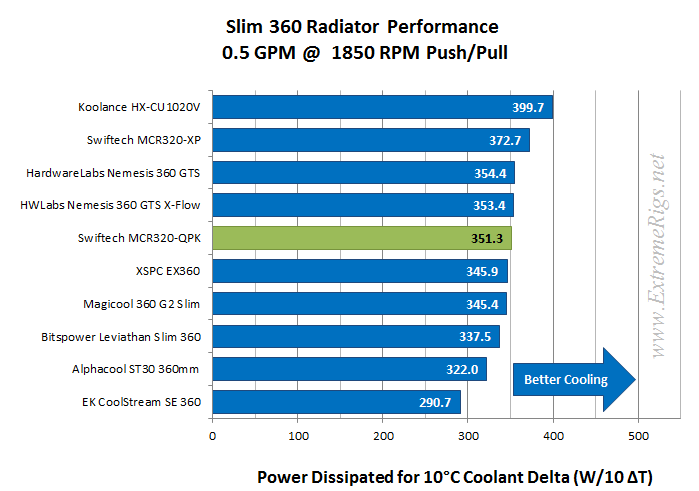
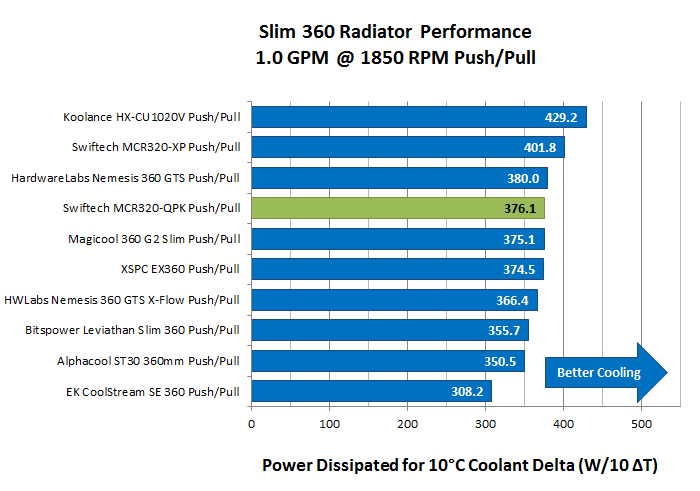
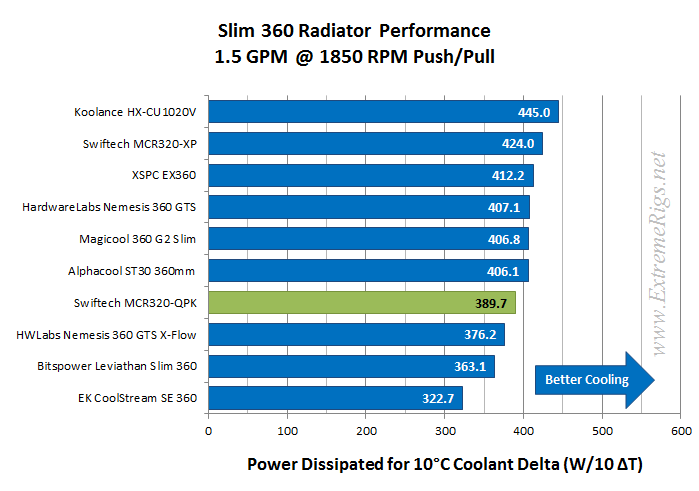
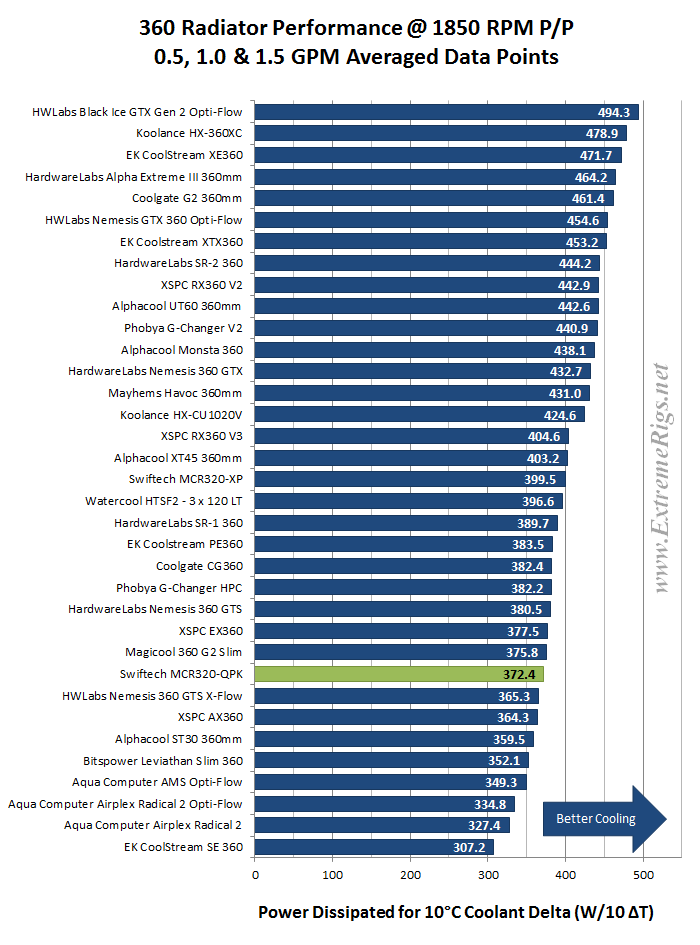
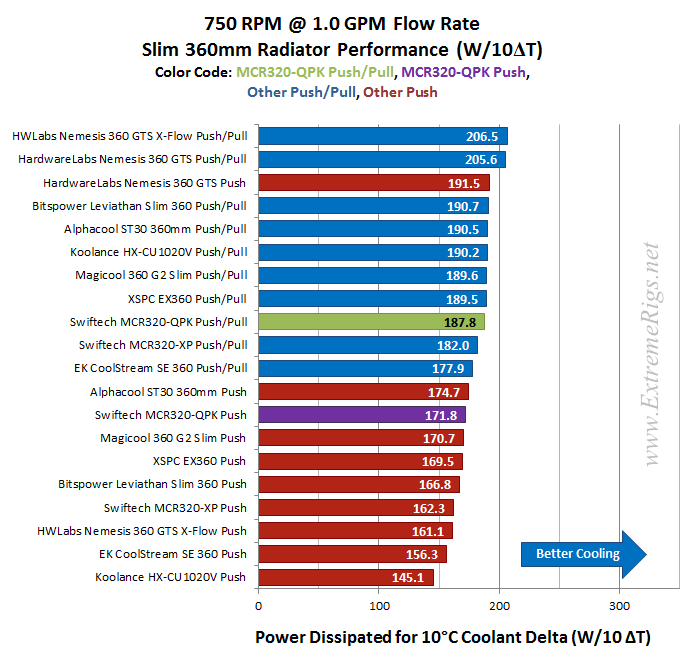
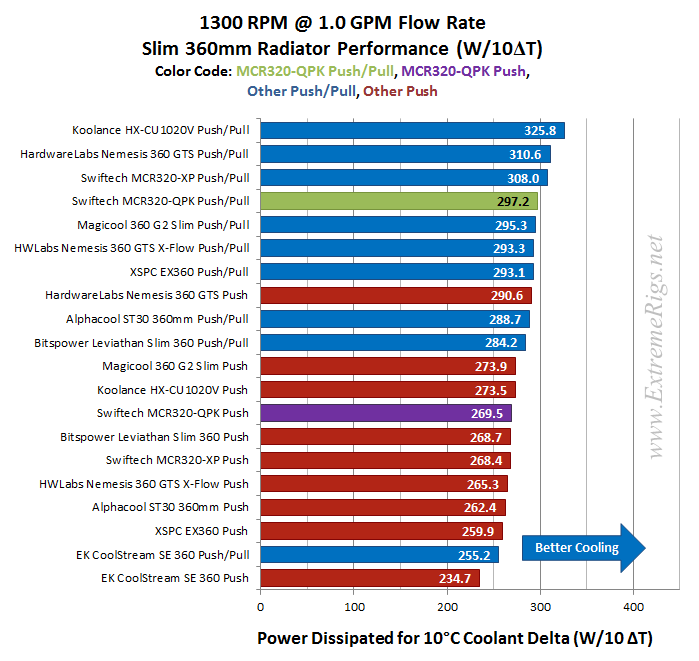
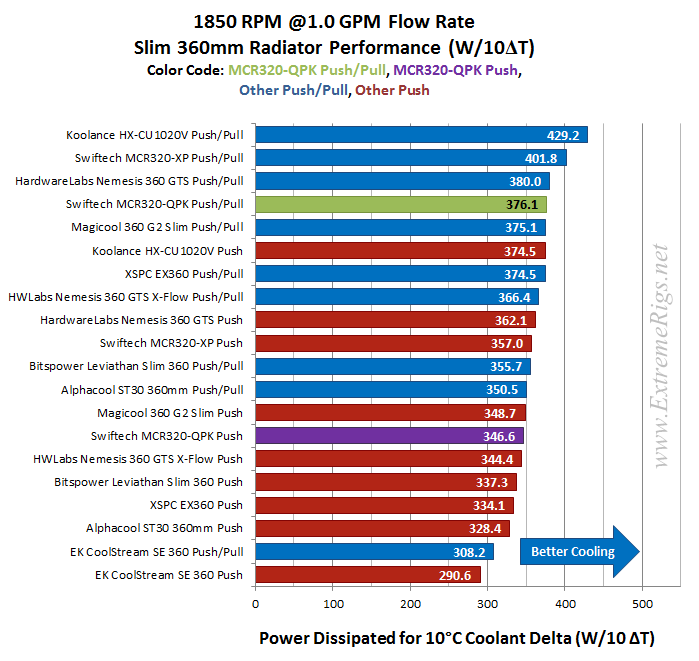
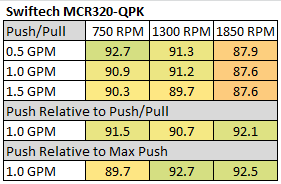
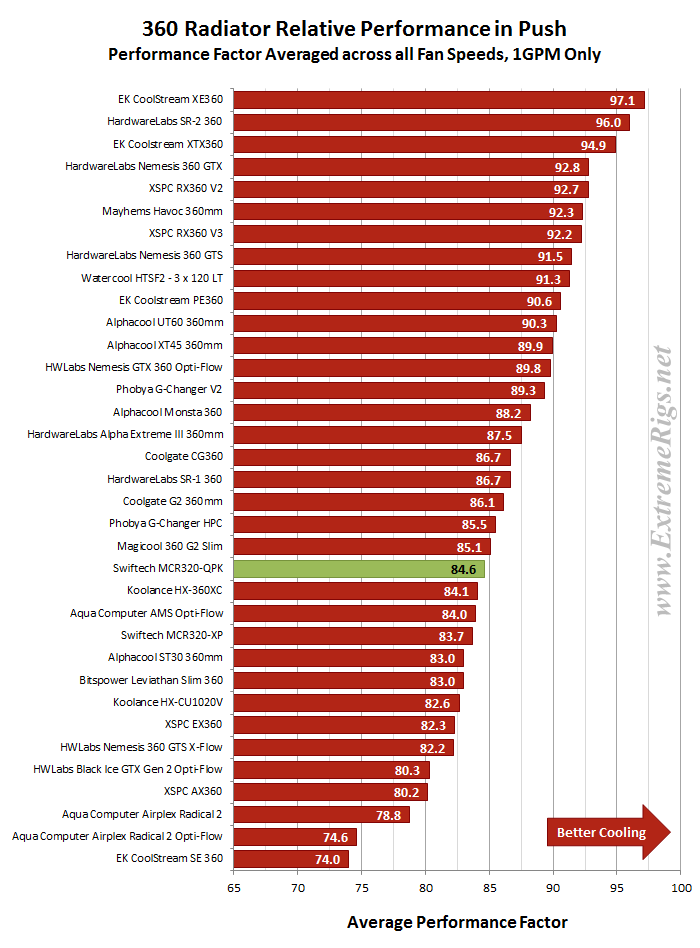
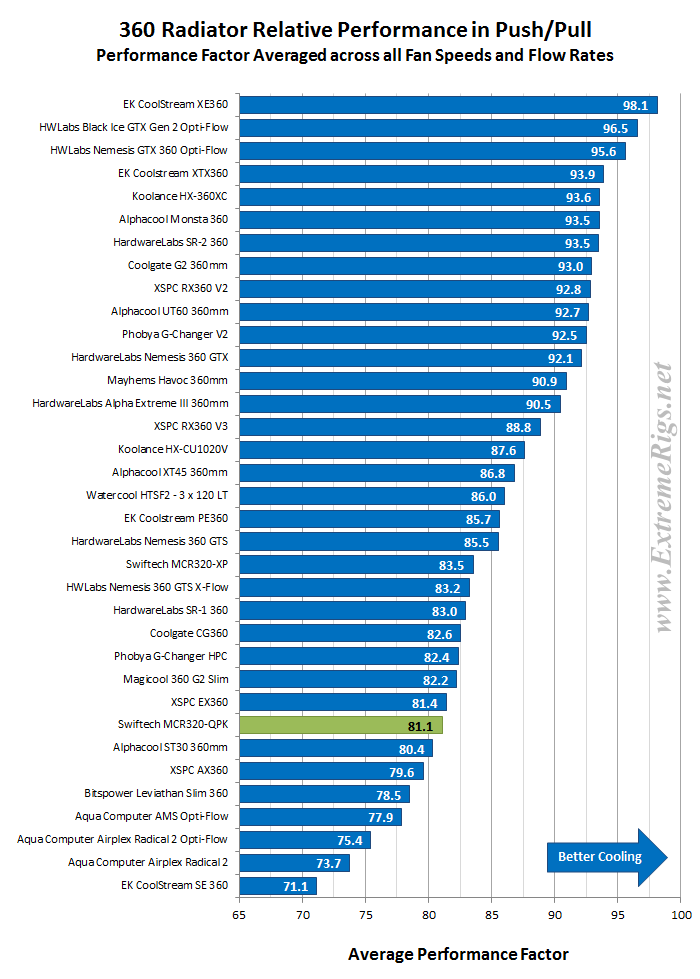
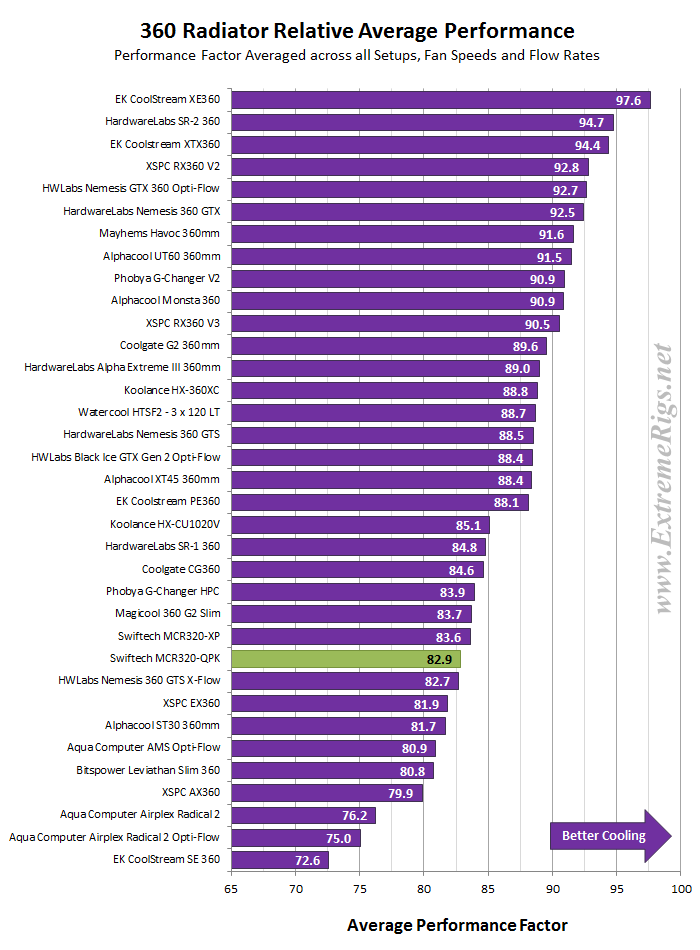
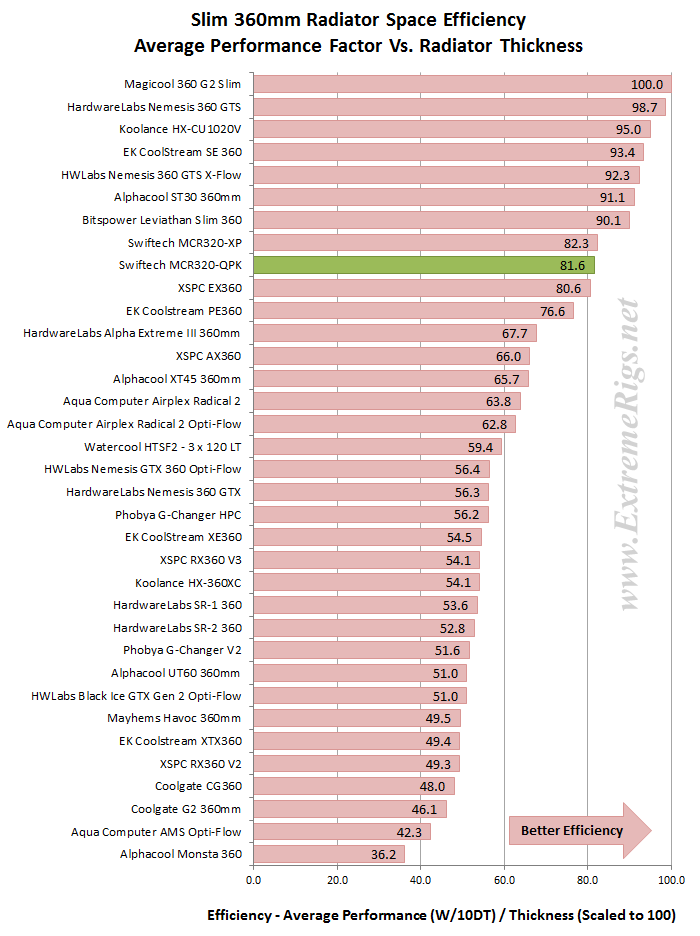
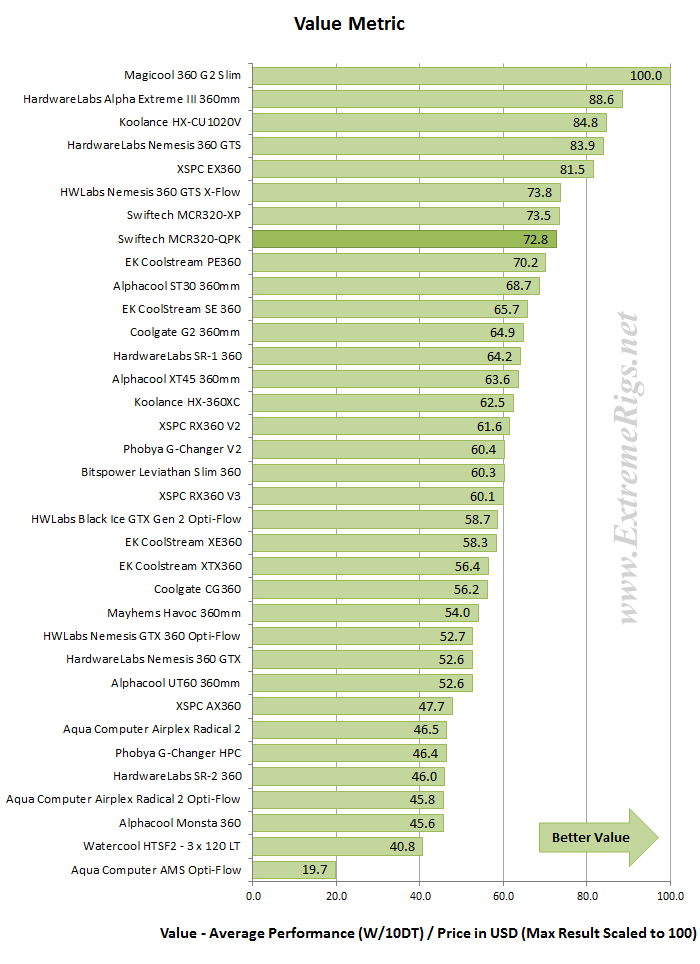



Comments are closed.